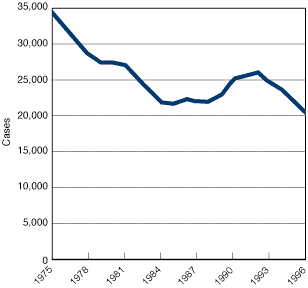 |
Treatment Research
Volume 13, Number 3 (July, 1998) |
The Rise and Fall of TB In the United States
After decades of decline, tuberculosis (TB) re-emerged during the 1980s to mount a new threat to the Nation's public health. From a low of 22,201 cases in 1985, TB rates started to increase in the remaining years of the decade, according to the Centers for Disease Control and Prevention (CDC). The rise in new TB cases accelerated into the early 1990s, peaking at 26,673 in 1992.
Injecting drug use and the onset of the HIV/AIDS epidemic during the 1980s both have played important roles in the resurgence of TB. Rates of latent, or inactive, TB have always been high among injecting drug users. NIDA-supported studies show that HIV infection, which is also prevalent among injecting drug users, can activate this latent TB and accelerate the course of the disease. Lack of access to TB therapy or failure to complete a full course of therapy also contributes to development of active TB and transmission of the infection.
Tuberculosis Cases Reported in the U.S.
1975-1996 |

After many years of declining, TB rates in the United States started to increase again in 1986, and accelerated into the early 1990s, peaking at 26,673 in 1992. Since then, new TB cases have declined, falling to an all-time low in 1996.
Source: Center for Disease Control and Prevention
|
To counter the threat of TB, a number of Federal agencies, including the National Institutes of Health (NIH) and CDC, worked with State health departments in the early 1990s to develop a national TB elimination strategy. As a result, State and local health departments received increased Federal resources to improve their TB prevention and control programs, and NIH institutes increased their funding for TB research. The resulting NIDA-supported TB research focused on charting the course of TB among drug users and improving strategies to halt its spread by increasing drug users' adherence to TB medication regimens.
This coordinated effort led to the development of effective strategies to identify and treat persons with TB. As a result, the tide of TB now appears to have turned in the United States. Nationally, new TB cases have been on the decline since 1992. In 1996, new TB cases fell to an all-time low of 21,337 cases, according to the most recent statistics from the CDC.
"The national TB control strategy has been very effective," says Dr. Henry Francis, director of NIDA's new Center on AIDS and Other Medical Consequences of Drug Abuse. However, rates of latent TB infection remain high among injecting drug users and in geographical pockets and have the potential for active disease and transmission, he notes. "It is important to maintain our vigilance, or we will see TB rates start to climb again," he says.
Sources
Centers for Disease Control and Prevention. Tuberculosis morbidity United States, 1996. Morbidity and Mortality Weekly Report 46(30):695-700, 1997.
|
NIDA NOTES - Volume 13, Number 3 |
[NIDA Home Page][NIDA NOTES Index][Index of this Issue]
|